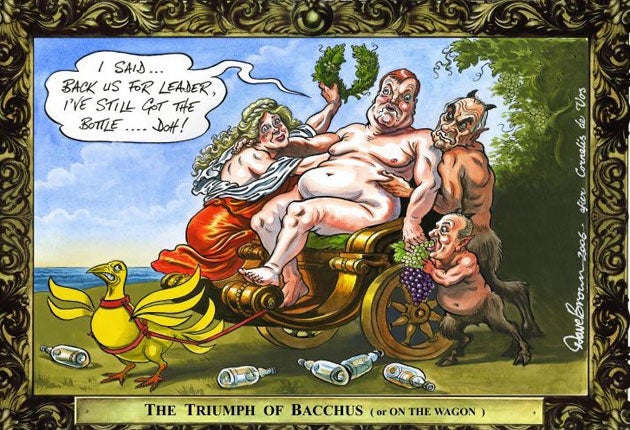Ink and the Bottle, Cartoon Museum, London
This vintage satire leaves a sharp taste

Your support helps us to tell the story
From reproductive rights to climate change to Big Tech, The Independent is on the ground when the story is developing. Whether it's investigating the financials of Elon Musk's pro-Trump PAC or producing our latest documentary, 'The A Word', which shines a light on the American women fighting for reproductive rights, we know how important it is to parse out the facts from the messaging.
At such a critical moment in US history, we need reporters on the ground. Your donation allows us to keep sending journalists to speak to both sides of the story.
The Independent is trusted by Americans across the entire political spectrum. And unlike many other quality news outlets, we choose not to lock Americans out of our reporting and analysis with paywalls. We believe quality journalism should be available to everyone, paid for by those who can afford it.
Your support makes all the difference."Ah Andy Capp, you wife-beating drunk," chuckled Homer in an episode of The Simpsons. That comment gets to the nub of the occasionally questionable relationship between comedy and drink. Ink and the Bottle, a cheerfully reflective exhibition at the Cartoon Museum, includes four cartoons featuring Capp, the Mirror's workshy alky, alongside images by William Hogarth, Heath Robinson and Ronald Searle. Attitudes on display range from the disgust of the Victorian teetotaller George Cruikshank to an indulgent Giles cartoon from 1960 which wrings a cheap gag out of drunken driving.
It is interesting how frequently drunks crop up in cartoons. The first great cartoon character in the UK was Ally Sloper, a dissolute Victorian who starred in his own magazine, Ally Sloper's Half Holiday. Satirists from James Gillray to Viz have relished the chance to make fun of the drinker's pickled features.
While beer is often tolerated, gin has been used as a potent symbol of excess. In 1751, Hogarth's Gin Lane depicted an errant mother feeding her baby a nip of gin; by 1949, this view had hardened. James Fitton's cartoon asks "Do you believe in the innocence of children?" beneath a striking image of a malevolent child pouring gin into his own milk bottle.
Cruikshank, whose father, Isaac, died after a drinking contest, embraced the anti-gin spirit with The Bottle and The Drunkard's Children. These Hogarthian morality tales look at the degrading impact of drink on two generations of one family and bookend his epicWorship of Bacchus, an elaborate panorama that demonstrated how alcohol was implicated in every avenue of society.
There is plenty of lighter stuff here too, from the semi-alcoholic Viz celebrity Roger Mellie to some wonderful pink elephants by the seaside postcard artist Donald McGill. Roger Penwill's image of a man telling a waiter to "Bring a wine that's suitably pompous" sits next to Viz's Real Ale Twats discussing "Blewitt's Whistling Dixie" and "Oxter's Hairy Hog".
More vicious satire comes from Gillray, who depicted a wine-swilling William Pitt in 1795. This is hung next to a cartoon by Dave Brown of The Independent, published in 2006, the day after the Liberal Democrat leader Charles Kennedy admitted to problems with alcohol. There is, however, no image of that great drinker Winston Churchill, indicating the huge hole in satire that occurred between the Georgian era and the birth of Private Eye.
That could be because cartoonists don't like pointing fingers if they are fond of a drink or two themselves. Steve Bell's If occasionally places a bearded Bell-like character in the role of bar-room fantasist; Jak of the Evening Standard was fond of long lunches; Searle produced memorable images for Oddbins.
The last word should go to the Victorian artist Phil May, who told somebody admiring his bright red drinkers' nose that "it is my most prize possession, having cost me £30,000 to acquire it".
To 13 February ( www.cartoonmuseum.org)
Join our commenting forum
Join thought-provoking conversations, follow other Independent readers and see their replies
Comments